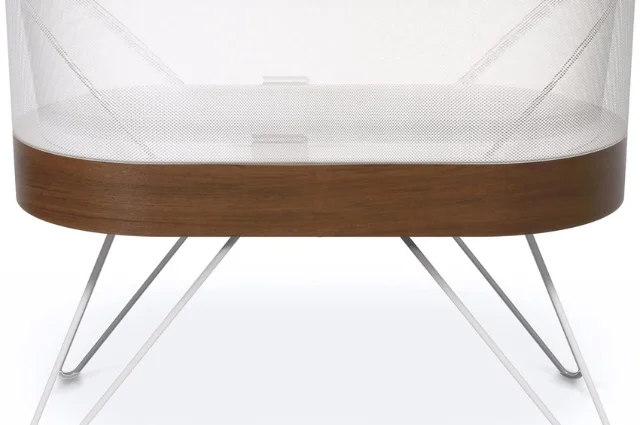Looking for ways to keep your baby from sliding down an elevated crib? Newborns are exciting to have around but they also come with lots of care and monitoring. It is natural for you as a parent to want to keep your little one safe as much as possible. Pediatricians are adamantly against co-sleeping hence it is recommended that infants should be put in a separate crib for at least the first six months to ensure their safety. A crib is specifically made for babies. It is designed with baby-friendly rails in such a way that it prevents your baby from rolling over and getting injured.
Often, newborns are placed on an elevated crib for different reasons which mainly include easing the pain of reflux in their babies. Bedtime can be the most uncomfortable time for your baby if he/ she has symptoms of reflux. Parents, especially first-time moms are usually worried about how to keep the baby from sliding down the elevated crib. Here is what you should know.
Is it ok to elevate my baby’s crib?
Reflux in children happens when food and acid from the stomach go back up into the esophagus. Reflux gets worse at night due to gravity. When your little one lays down to sleep at night, the effect of gravity on the food movement through the digestive system is lost. Hence, the pain and lack of comfort your little one feels. A common solution to ease the pain your baby has from reflux is to elevate your little one’s crib so that the feet of your baby are lower than his/her head. Sleeping in an inclined position ensures the drainage of fluid away from the face and head area.
It is important to ensure that your baby’s head is elevated to about 15° to 30° higher than the feet. You might begin to wonder if it is ok to elevate your baby’s crib so you can relieve the symptoms of reflux. Although elevating a baby’s crib has been seen to relieve the pain of reflux, some pediatricians still do not recommend that you elevate your baby’s crib.
How to keep baby from sliding down elevated crib
- Use a sleep positioner to keep the baby from sliding
Sleep positioner is a common choice of parents to ensure that their little one doesn’t slide down the elevated crib. Sleep positioner gives your baby the safety and comfort needed while sleeping while preventing your baby from having the pain of reflux. Ensure that the sleep positioner you use for your little one is made from breathable materials or 100% mesh to ensure constant airflow and to prevent any case of SIDS. Some sleep positioners come with an inclined wedge to give instant relief.
- Use a thin towel or blanket
To use a thin towel or blanket to elevate your little one’s crib, you need to measure the length first. To do this, remove your baby’s mattress from the crib and measure about 5-6 inches from the bottom of the crib. This should give you the perfect incline which is between 15° – 30°. Next, you need to place your baby’s mattress back into the crib to rest on the new height that you have created. Also, ensure that no loose blanket or towel is sticking out to prevent your little one from pulling it out and being at risk of SIDS.
- Use a pillow under the mattress
You can also use a pillow to elevate your baby’s crib so the effect of reflux can be reduced. Remove your baby’s mattress from the crib and measure about 5-6 inches from the ground. The exact height you would measure depends on how thick the pillow is. Ensure that the loose ends of the pillow are not popping out to prevent your baby from disrupting what you have done. Another option is to secure the pillow with Velcro tape so that it stays intact and prevents your little one from pulling it out.
- Use a tucker sling
A tucker sling ensures that your baby is comfortable and safe even while trying to prevent the pain of reflux. A tucker sling fits around the elevated part of the mattress and a diaper-shaped section fits between your little one’s legs and fastens around the waist with Velcro. The tucker sling is designed with a Velcro fastener to ensure your baby does not slip off. It also accommodates babies weighing from under 2 pounds – 300 pounds.
- Use a crib wedge
Another option that you can use when trying to elevate your baby’s crib is to use a crib wedge. A crib wedge is a device that looks like a mattress shaped in the form of a wedge. It is made using the same width as the crib. A crib wedge is supposed to be wedged beneath your baby’s mattress. Using a crib wedge is recommended because you do not have to worry about it sticking out and putting your baby at risk of a choking hazard.
- Ensure baby is placed in the correct position
Your baby’s position on the elevated bed is important to ease the pain of reflux. Ensure you position the head of your little one so it stays higher than his/her stomach. Your baby mustn’t be so high up to prevent your baby from sliding down while sleeping.
Different people would have different suggestions on how to elevate your baby’s crib but ensure you avoid unsafe methods like putting books, blocks, or other objects under the leg of your baby’s crib as this could lose its balance and create a more fatal problem. If you notice that the mattress is too high after elevating it, you can bring it an inch down to ensure your baby’s safety. Most children would outgrow reflux as soon as they can sit up so this is not a case to panic. You can also visit your pediatrician for more advice if you do not notice relief in your little one or have concerns about the symptoms of reflux.




